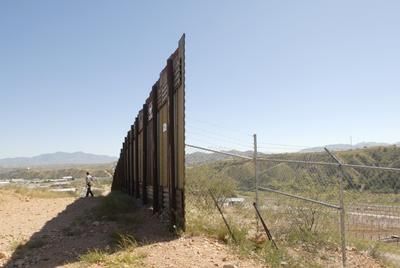 |
| The US-Mexico border fence in Nogales, one mile east of the
Mariposa Port of Entry. |
Border fence could be new president's problem
 |
| The US-Mexico border fence in Nogales, one mile east of the
Mariposa Port of Entry. |
The Associated Press
WASHINGTON — The head of the agency that oversees the Border Patrol
said Wednesday he cannot promise to meet President Bush's goal of completing
a Southwest border fence when he leaves office in January.
The plan calls for finishing building 670 miles of fencing along the
U.S.-Mexico border by year's end; so far, 344 miles are complete. But Ralph
Basham, commissioner of Customs and Border Protection, told lawmakers he
only could assure that the remaining portions of fence would be under contract
or under construction when the Bush administration is over.
He also said the agency needs an additional $400 million to complete
the project. Basham cited higher costs for fuel, steel and labor.
"We face many challenges in achieving our goal," Basham told the House
Homeland Security Committee.
The Sept. 11 attacks revived the immigration debate and advanced the
idea of a border fence. Intelligence officials have said gaps along the
southwestern border could provide opportunities for terrorists to enter
the United States.
The fence is not intended to stop illegal immigration altogether, but
make it more difficult for people to get into the U.S. illegally, administration
officials say.
The overall plan for security on that border includes additional Border
Patrol agents, more enforcement of immigration laws, the fence and a high-tech
"virtual fence" with surveillance technology.
Boeing Co. has the contract for the technology portion of the fence,
as well as for some construction work. Boeing's contract for the technology
is up in 2009. If the administration is not satisfied with the work Boeing
has done, the Government Accountability Office — Congress' investigative
arm — suggested that a new contractor take over. According to the GAO,
Boeing has $933 million worth of work on the project.
Since 2006, Congress has set aside $2.7 billion for the fence. But
there's no estimate how much the entire system — the physical fence and
technology — will cost to build, let alone maintain.
The technology portion has run into problems. It once was billed as
a relatively easy plan to use off-the-shelf technology to help federal
agents spot illegal crossers. When a GAO investigator toured a stretch
of the "virtual fence" three months ago, it took 45 minutes to get the
surveillance system up and running. The system includes towers with radar,
cameras and communications equipment.
Basham told lawmakers, however, that the priority is to complete the
physical fence.